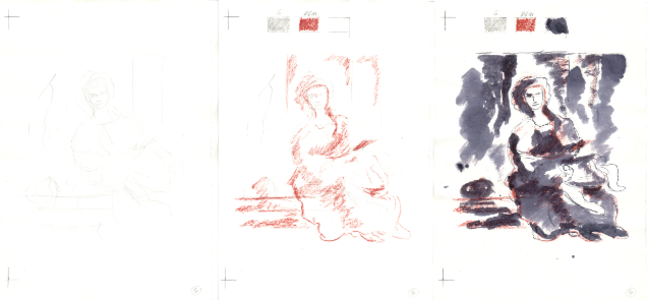Old Master Drawing Image Analysis
Recently, the progress in computer science made links between this field and art history possible. The examination of cultural artifacts particularly gained new insights in materials and object structure from new possibilities in high-resolution image acquisition and data processing. However, although there is a large number of specialized examination methods (for example IR/UV reflectography, fluorescence, micro-XRF, Raman spectroscopy), the research on hand drawings still suffers from major diagnostic gaps: due to the particular properties of red chalk, it is currently not possible to visualize preparatory drawings from red chalk if they have been overlaid by inks.
Up until the end of the 19th century, hand drawings were typically created with different materials in several working steps. In the final drawing, multiple layers of different materials overlap, such that the lower, older layers can oftentimes not be identified visually. However, these layers represent the various steps of the genesis of the respective work. Thus, separating these layers by means of imaging and image processing promises a direct look into the artistic creation process of the work. Therefore, such a technical approach may supply answers to key questions of art history on the object and the artist, and may help for objectivation of attribution and authenticity.
In this project, we investigate approaches to close this diagnostic gap. In contrast to image acquisitions with a limited spectral window (like infrared or ultraviolet light), we propose to image an object using a multispectral camera and to process the acquired data with methods from the field of pattern recognition. A multispectral camera operates primarily in the range of visible light but subdivides the light into much more channels than red, green, and blue. This allows differentiating materials of different physical compositions from their reflection patterns after processing the data with a computational algorithm. We evaluate our proposed methods on drawings that were created to exactly mimic the original work process, using the same materials and papers. The controlled creation process provides knowledge about the drawing layers, which allows assessing the accuracy of the method. This approach has the potential to avoid radiation damage to the work of art under examination, while still being able to provide meaningful information. Thus, it appears as a method that can have broad applications in the domain of art history and conservation of art that extend beyond the range of currently used approaches.
 |


 +49-9131-85-27775
+49-9131-85-27775
 +49-9131-85-27270
+49-9131-85-27270
